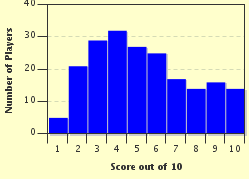Quiz Answer Key and Fun Facts
1. "Youthful Self-Portrait" was painted in 1613-14 when the artist was in his mid-teens. An early work by a Flemish Baroque artist, you might find him easier to recognize if he had a beard. Who is the artist?
2. This artist was 69-years-old when he painted "Self Portrait" in 1910. Suffering from rheumatoid arthritis, he had recently moved to warmer climes at a farm in Cagnes-sur-Mer, close to the Mediterranean coast. Who is this leading Impressionist artist?
3. This self-portrait was painted just a year before the artist's death at the age of 45 in 1543. One of the greatest portraitists of the 16th century, he was the official court painter for England's King Henry VIII. Who is this a Northern Renaissance-style artist?
4. Dating to 1660, the artist was in his mid-50s when he painted "Self-Portrait at the Easel". The artist was by then into his final period, with richer colours and more pronounced (and sometimes described as 'coarse') brush strokes. Who is this artist from the Dutch Golden Age?
5. "Self-portrait with Palette" was painted just four years before his death in 1883 and is his only self-portrait. A prolific artist, he developed a technique, at odds with the layered method in vogue at the time, that allowed him to complete a painting in a single sitting. Who is this artist?
6. Painted in 1889, "Portrait of the Artist with the Yellow Christ" is a self-portrait with a version of another of the artist's works from that same year behind him. His experimentation with colour began the Synthetist style and he is now considered the founder of the Primitivism art movement. Who is this Post-Impressionist artist?
7. This gouache and watercolor over graphite on paper self-portrait dates to 1880. Although she lived much of her life in France, this artist has been honoured on a US postage stamp and even had a WWII Liberty ship named for her. She was described in 1894 as one of "les trois grandes dames" of Impressionism. Who is this artist?
8. Born in 1724, "Self-Portrait, Oval" is an unique work by one of the best-known English artists of the 18th century. Most of his paintings are today spread between the Royal Collection, the Tate Gallery and National Museums Liverpool, and this is his lone contribution to the National Portrait Gallery. Who is this artist?
9. Painted in 1745, "The Painter and his Pug" lies at the more realistic end of the spectrum of this artist's portrait work. At the opposite end are some of his more outlandish cartoons, and it was these that made him into one of the great influences on caricaturists of later eras. Who is this artist?
10. This self-portrait was painted in 1860, just three years before the artist's death at the age of 65, but he depicts himself at an earlier stage of his life. He began his painting career at the height of the Neoclassical period, but developed to become the leading artist in the French Romantic movement. Who is this artist?
Source: Author
EnglishJedi
This quiz was reviewed by FunTrivia editor
Pagiedamon before going online.
Any errors found in FunTrivia content are routinely corrected through our feedback system.


